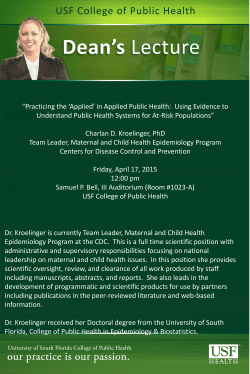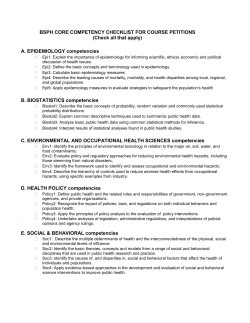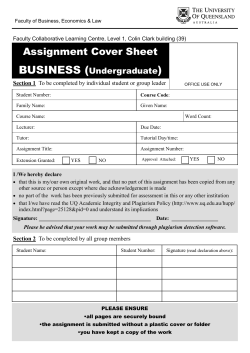
Syllabus for BIOSTAT615 - University of Michigan School of Public
Biostatistics 615 – Statistical Computing Fall 2014, September 2 – December 10 Instructor: Hui Jiang Email: jianghui@umich.edu Office: M4523 SPH II Time: Tuesday & Thursday 8:30AM - 10:00AM Room: M1112 SPH II Couse Web Page: CTools Objective Biostatistics 615 aims to provide students with a practical understanding of computational issues related to the implementation of statistical methods, from basics of programming language to inner workings of sophisticated statistical methods. C++ and R languages will be used throughout the course. Prerequisites Linear algebra (matrix theory) and basic statistics including probability distribution, linear model and hypothesis testing. Biostatistics 601 or equivalent is required prior to or in parallel to taking Biostatistics 615. Previous experience in programming is not required, but those who do not have previous programming experience should expect to spend additional time studying and learning to be familiar with a programming language during the coursework. Books 1. (Optional) Cormen, Leiserson, Rivest, and Stein, "Introduction to Algorithms", Third Edition, The MIT Press, 2009 2. (Optional) Stephen Prata, “C++ Primer Plus”, Sixth Edition, Addison-Wesley, 2011 3. (Optional) Press, Teukolsky, Vetterling, and Flannery, "Numerical Recipes", 3rd Edition, Cambridge University Press, 2007 Grading Homework assignments will be given out at approximately every two weeks. You are encouraged to discuss homework problems with fellow students; however, you must implement and write up the assignment on your own. Plagiarism will not be tolerated. Homework: 60% Group (team of 2) Final Project: 40% Standards of Academic Act The following is an extract from the School of Public Health's Student Code of Conduct. Student academic misconduct includes behavior involving plagiarism, cheating, fabrication, falsification of records or official documents, intentional misuse of equipment or materials, and aiding and abetting the perpetration of such acts. The preparation of reports, papers, and examinations, assigned on an individual basis, must represent each student’s own effort. Reference sources should be indicated clearly. The use of assistance from other students or aids of any kind during a written examination, except when the use of books or notes has been approved by an instructor, is a violation of the standard of academic conduct. In the context of this course, any work you hand-in should be your own and any material that is a transcript (or interpreted transcript) of work by others must be clearly labeled as such. Topics Part I : Basics of C++, R, Data Structure and Algorithms o Introduction to C++ o Computational Time Complexity o Key Data Structures o Sorting Algorithms o o o o Divide and Conquer Algorithms Dynamic Programming Introduction to R Interfacing C++ and R languages Part II : Numerical and Statistical Methods (a selected subset of the following topics will be covered) o Matrix Algebra and Least Square Methods o Root Finding and Optimization o Hidden Markov Models o Expectation-Maximization (EM) Algorithm o Random Number Generation o Numerical Integration and Importance Sampling o Markov-Chain Monte-Carlo (MCMC) Methods Core Competencies The Council for Education in Public Health recommends every course document in the Public Health competencies covered in its subject syllabus. This is the list of competencies covered by Biostatistics 615 Biostatistics o Describe the roles biostatistics serves in the discipline of public health. o Describe basic concepts of probability, random variation, and commonly used statistical probability distributions. o Describe preferred methodological alternatives to commonly used statistical methods when assumptions are not met. o Distinguish among the different measurement scales and the implications for selection of statistical methods to be used based on these distinctions. o Apply descriptive techniques commonly used to summarize public health data. o Apply common statistical methods for inference. o Apply descriptive and inferential methodologies according to the type of study design for answering a particular research question. o Apply basic informatics techniques with vital statistics and public health records in the description of public health characteristics and in public health research and evaluation. o Interpret results of statistical analyses found in public health studies. o Develop written and oral presentations based on statistical analyses for both public health professionals and educated lay audiences. Epidemiology o Apply the basic terminology and definitions of epidemiology. o Calculate basic epidemiology measures. o Communicate epidemiologic information to lay and professional audiences. o Draw appropriate inferences from epidemiologic data. o Evaluate the strengths and limitations of epidemiologic reports. Health Behavior and Health Education (Social and Behavioral Sciences) o Apply evidence-based approaches in the development and evaluation of social and behavioral science interventions. Cross-Cutting Competencies o Demonstrate effective written and oral skills for communicating with different audiences in the context of professional public health activities. o Articulate an achievable mission, set of core values, and vision. o Demonstrate team building, negotiation, and conflict-management skills. o Apply evidence-based principles and the scientific knowledge base to critical evaluation and decision making in public health. o Appreciate the importance of working collaboratively with diverse communities and constituencies (e.g., researchers, practitioners, agencies, and organizations).
© Copyright 2025





















